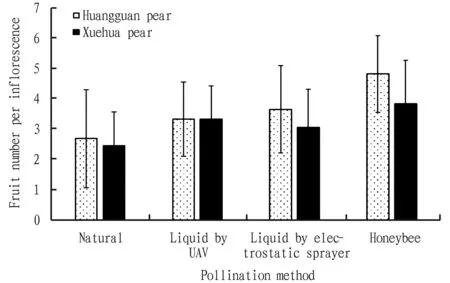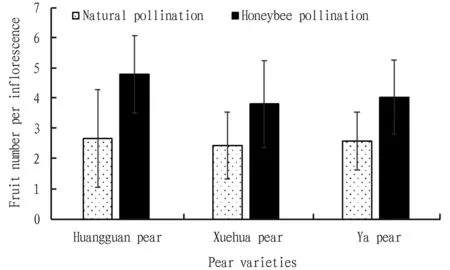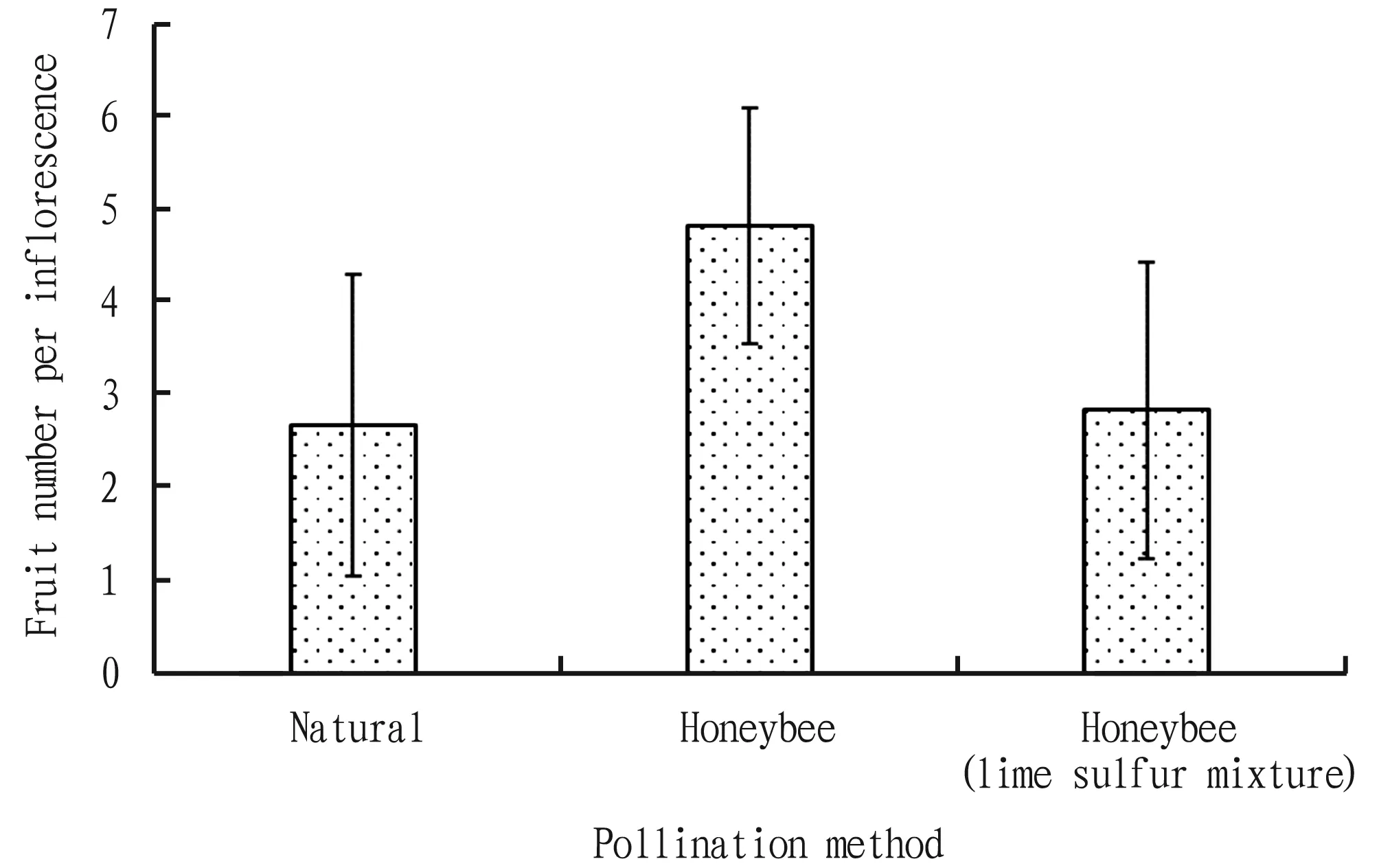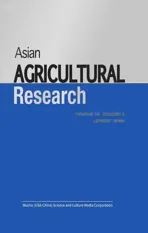Pollination Effects of Pear Trees by Honeybee and Its Influencing Factors
2023-08-30JinWANGYaruWANGHongbaoWANGXiaoLIYingtaoWANGYongboWANGYongLI
Jin WANG, Yaru WANG, Hongbao WANG, Xiao LI, Yingtao WANG, Yongbo WANG, Yong LI
Shijiazhuang Pomology Institute, Hebei Academy of Agricultural and Forestry Sciences, Shijiazhuang 050061, China
Abstract [Objectives] To improve the yield and quality of different pear varieties by supplementary pollination. [Methods] The effects of bee pollination were compared with other pollination methods, and the effects of different factors on honeybee pollination were studied through experiments. [Results] Honeybee pollination significantly increased the number of fruit per inflorescence. In addition, it could improve the single fruit weight, fruit shape and other quality indicators of fruit. The pollination effect of honeybee was the best in all supplementary pollination measures. Honeybee pollination had good fruit setting effect on different pear varieties, but there were some differences in the effect of quality improvement. Spraying lime sulfur mixture and other measures could significantly affect the effects of honeybee pollination. [Conclusions] The research results prove the effectiveness of honeybee pollination technology in Hebei Province, and provide a certain reference for the establishment of a simple and practical artificial assisted pollination technology system.
Key words Pear, Honeybee, Pollination
1 Introduction
Generally, a flower contains both pistils and stamens, and pollen easily contacts with pistils to complete fertilization, which is called self-pollination. However, after self-pollination, the elongation of pollen tubes in the style of most pear varieties is inhibited, resulting in the failure of successful fertilization, resulting in the failure of fruit setting or poor fruit development[1-2]. Major pear varieties in Hebei Province include Huangguan pear, Ya pear, and Xuehua pear, and Hongxiangsu, Qiuyue. And Sucui No.1 introduced in recent years. All of these varieties are self-fertile varieties. Therefore, different varieties of pollination trees are usually allocated in pear orchards in production. When there are enough pollination species in the pear orchard, natural pollination by wind and insects can ensure the yield and quality of pears to a certain extent. However, it has some limitations, such as the lack of effective supplementary pollination methods, which may easily lead to unstable yield or even a large reduction in production, affecting the yield and quality of pears in that year.
At present, the supplementary pollination methods commonly used in production include artificial pollination, artificial spray pollination, liquid spray pollination, releasing honeybees for pollination,etc.[3]. Although the manual method is effective, it is laborious, inefficient and not suitable for popularization in a large area. Honeybee pollination has the effect of increasing yield and improving fruit quality, which has been confirmed in various yield-increasing experiments both at home and abroad. Since the 1950s, China has carried out experiments on increasing the yield of apples. However, although releasing honeybees for pollination has been widely used in other crops, its application in pear industry is still in its infancy. Especially under the specific climate and environmental conditions in Hebei Province, its application is blank. In order to explore the effect of the new pollination method, our research team carried out a series of comparative experiments around the releasing honeybees for pollination method as the core technology to verify the effectiveness and influencing factors of the method, with a view to providing a reference for the establishment of a simple and practical artificial pollination technology system.
2 Materials and methods
2.1 MaterialsThe pear varieties include Xuehua pear, Huangguan pear and Ya pear. The experimental agents included pollination solution (each 100 kg of pollination solution contained 20 g of xanthan gum, 50 g of calcium gluconate, 10 g of boric acid, 10 kg of white sugar, and 40-80 g of commercial Ya pear pollen) and lime sulfur mixture. Honeybee species were Italian bees suitable for climate conditions in North China. The knapsack electrostatic sprayer was provided by Nanjing Agricultural University, and the UAV adopted Dajiang UAV T40 agricultural drone.
2.2 Methods
2.2.1Comparative experiments of different pollination methods. The experimental site was located in Fanzhuang Town, Zhaoxian County, Hebei Province, and Xuehua pear and Huangguan pear were selected. In this experiment, natural pollination, releasing honeybees for pollination, liquid pollination by electrostatic sprayer and liquid pollination by UAV were used to carry out comparative experiments. For the releasing honeybees for pollination, on April 1, 2022, artificial beehive releasing measures were taken, 2 hives of honeybees were placed every 0.333 ha in the experimental area, and 10 trees with different distances from the hive were randomly selected to mark for subsequent investigation and sampling. The liquid pollination by electrostatic sprayer and liquid pollination by UAV were carried out in full bloom from April 2 to 4, 2022. Spray pollination was carried out twice for each method, again with 10 trees per treatment. The natural pollination was taken as the control. The honeybee pollination was set more than 3 km away from other treatments to prevent mutual influence.
2.2.2Comparative experiment on effect of releasing honeybees for pollination method on different varieties. The experimental sites were Fanzhuang Town and Xiezhuang Township, Zhaoxian County. In this experiment, Xuehua pear, Huangguan pear and Ya pear were selected to carry out a comparative experiment in the orchard of 0.133 ha each, with natural pollination as the control and releasing honeybees for pollination as the treatment. The method of releasing honeybees for pollination was the same as above.
2.2.3Experiment on the effect of spraying before flowering on the method of releasing honeybees for pollination. The experiment was conducted in Xiezhuang Township, Zhaoxian County, and the tested variety was Huangguan pear. Huangguan pearl orchard with a plot of 0.333 ha was selected to be pre-sprayed with lime sulfur mixture with a concentration of 5 Baume degrees in the first and middle ten days of March (before flower bud blooming). Another 0.333 ha without lime sulfur mixture was taken as the control. The method of releasing honeybees for pollination was the same as above.
2.2.4Sampling indicator determination and data processing. After the above three experimental treatments, when the natural fruit drop was completed and the young fruit development was stable, the inflorescence fruit setting rate of each treatment was investigated and recorded, and 30 inflorescences were selected for each treatment. After fruit ripening, 20 fruits were collected from each treatment, and the single fruit weight, vertical and horizontal diameters, calyx shedding rate, soluble solids, hardness and other indicators were detected. SPSS 20.0 and Excel were used for statistical analysis and diagram plotting.
3 Results and analysis
3.1 Comparative experiment of different pollination methodsThe inflorescence fruit setting results of different pollination methods are shown in Fig.1, and the natural pollination was taken as the control. In addition, three treatments of liquid pollination by UAV, liquid pollination by electrostatic sprayer and honeybee pollination were used. Huangguan and Xuehua pear were selected as test varieties. In general, the number of fruit set per inflorescence by different pollination methods was higher than that by natural pollination. There was no significant difference between liquid pollination by UAV and liquid pollination by electrostatic sprayer. The honeybee pollination showed the optimal effect. The number of fruit per inflorescence of Huangguan pear and Xuehua pear was 4.82 and 3.83, respectively, which was significantly higher than that of natural pollination (2.68 and 2.45). Compared with natural pollination, the fruit number per inflorescence of Huangguan pear and Xuehua pear treated with honeybee pollination increased by 79.8% and 56.3%, respectively.

Fig.1 Fruit number per inflorescence of pear trees with different pollination methods
The fruit quality of Huangguan pear with different pollination method is shown in Table 1. The average fruit weight of natural pollination Huang Guan pear was the lowest, only 291 g. All of that three supplementary pollination method could increase the single fruit weight of Huangguan pear fruit. The single fruit weight of honeybee pollination was the highest, up to 353 g. There was no significant difference in fruit shape index among different pollination methods, ranging from 0.95 to 1.01. The percentage of calyx shedding of natural pollination and honeybee pollination were similar, but the calyx shedding rate of liquid pollination was lower, only 50%-60%. Huangguan pear from honeybee pollination had the highest soluble solids content (12.58%), which was significantly higher than that from natural pollination (11.78%). Different pollination methods had little effect on the fruit firmness of Huangguan pear, and there was no significant difference among the treatments.

Table 1 Fruit quality of Huangguan pear with different pollination methods
The fruit quality of Xuehua pear with different pollination method is shown in Table 2. The average fruit weight of Xuehua pear in liquid pollination by UAV was the lowest, only 380.6 g, and the average fruit weight of honeybee pollination was the highest, up to 453.3 g. There was no significant difference in fruit shape index among the three supplementary pollination methods, ranging from 1.01 to 1.03, while the fruit shape index of natural pollination was 1.07, and the fruit shape was slightly longer. In terms of calyx shedding rate, the calyx shedding rate of natural pollination and honeybee pollination could reach 100%, while the calyx shedding rate of liquid pollination was low, only 80%-85%. Xuehua pear from honeybee pollination had the highest soluble solids content (13.78%), which was significantly higher than that from natural pollination (12.42%). Different pollination methods had little effect on the fruit firmness of Huangguan pear, and there was no obvious regularity among the treatments.

Table 2 Fruit quality of Xuehua pear with different pollination methods
The results showed that the releasing honeybees for pollination could effectively improve the fruit-setting rate of pear trees, the fruit-setting rate of honeybee pollination was high, and the young fruit developed well. Through the survey after full bloom, it was found that the fruit setting rate of honeybee pollination was higher than that of natural pollination. The fruit number per inflorescence of Huangguan pear and Xuehua pear treated with honeybee pollination increased by 56.3%-79.8% compared with natural pollination. Studies have confirmed that honeybee pollination can promote the development of fruit stalks, increase the thickness and growth, thereby increasing the fruit setting rate[4]. At the same time, the quality of the fruit was improved to a certain extent, the appearance consistency of the fruit was more uniform, the calyx shedding rate was high, and the commodity feature was good. The appearance quality of pear fruit was significantly affected by different attachment modes, the distribution of seeds in each ventricle, and the distribution and transportation of endogenous hormones, which could significantly improve the fruit shape index. The honeybee pollination could increase the number of seeds and the content of endogenous hormones in the young fruit stage, thereby improving the fruit shape and reducing the rate of malformed fruit[5]. In addition, honeybee pollination could also promote fruit development and sugar and acid synthesis, increase fruit weight and soluble solids content, and the results of this experiment are also consistent with this theory.
3.2 Comparative experiment of honeybee pollination method on different varietiesThe fruit setting rate of Xuehua pear, Huangguan pear and Ya pear after pollination was investigated in the planting base of Daan Jingyuan Pear Specialized Cooperative in Zhaoxian County and the planting base of Beijing Xinfadi Pear in Zhaoxian County. It was found that honeybee pollination significantly increased the number of fruit per inflorescence of all main varieties, among which Huangguan pear increased from 2.68 to 4.82, Xuehua pear from 2.45 to 3.83, and Ya pear from 2.61 to 4.06. Huangguan pear had a higher increase than Xuehua pear and Ya pear (Fig.2).

Fig.2 Effects of honeybee pollination on the number of fruits per inflorescence of different pear varieties
The effects of honeybee pollination on fruit quality of different varieties are shown in Table 3. After honeybee pollination, the single fruit weight and soluble solids content of all varieties were increased, among which Huangguan pear had the highest single fruit weight increase, and Xuehua pear had the highest soluble solids content increase. The honeybee pollination had no significant effect on fruit shape index, calyx shedding rate and firmness.

Table 3 Effects of honeybee pollination on fruit quality of different varieties
The effect of different varieties on honeybee pollination was excellent. Among them, honeybee pollination had the best effect on improving the yield of Huangguan pear and the quality of Xuehua pear. The results showed that different varieties had different responses to honeybee pollination.
3.3 Experiment on the effects of spraying treatment before flowering on releasing honeybees for pollination methodThe effects of releasing honeybees for pollination method were greatly influenced by the spraying treatment before flowering. The honeybee pollination effect was only 2.85 fruits per inflorescence in the pear orchard sprayed with lime sulfur mixture 5 d before honeybee releasing, which was not significantly different from that of natural pollination (Fig.3).

Fig.3 Effects of lime sulfur mixture on honeybee pollination
Table 4 shows the effects of lime sulfur mixture spray before flowering combined with honeybee pollination on fruit quality. There was no significant difference between the results of honeybee pollination and pure honeybee pollination after lime sulfur mixture, but the single fruit weight, vertical and horizontal diameter and soluble solids content after honeybee-pollination were higher than those after natural pollination. The effectiveness of releasing honeybees for pollination can also be affected by anthropogenic agricultural practices, and one of the most remarkable is the application of pesticides. Early pest control is very important for pear orchards. Lime sulfur mixture is a common pesticide in pear orchards in early spring. In this study, it was found that the lime sulfur mixture could significantly affect the honeybee pollination effect, and the number of fruit set was only increased by 11.7% when the lime sulfur mixture was applied before flowering and then releasing honeybees for pollination. However, the fruit number of the treatment group without lime sulfur mixture increased by 80.8%. Therefore, in the promotion of honeybee pollination in the future, lime sulfur mixture and other pesticides should be applied as early as possible, as far as possible from late February to early March before the germination of fruit trees, to ensure that pesticides are not used 15 d before the date of releasing honeybees.

Table 4 Effects of lime sulfur mixture and honeybee pollination on fruit quality of Huangguan pear before flowering
4 Conclusions
The honeybee pollination technology is suitable for pear producing areas in Hebei Province. This technology can significantly improve the fruit setting rate and fruit quality of various varieties. It is effective for most varieties, but its application is also affected by certain environmental and human measures, such as pesticide application. Therefore, it is recommended to make relevant prediction and planning before use. This series of experiments showed that releasing honeybees for pollination played an important role in increasing yield, improving quality, saving cost and increasing efficiency of pear production. With the development of modern agriculture, honeybee pollination has broad application prospects in the future pear industry.
杂志排行
Asian Agricultural Research的其它文章
- Impact of Sharp Fluctuations of Live Pig Prices on Financial Capacity of Pig Breeding Enterprises: An Analysis Based on the Data of Listed Enterprises from 2018 to 2021
- Construction of the "Three-integration" Rolling Development Mode in the Urban-rural Fringe from the Perspective of Thematic Business Engine: A Case Study of "Zhucheng Dinosaur Eco-city" in Shandong Province
- Relationship between Rural Industry Revitalization and Land Resource Utilization and Its Practice in Ganning Town, Wanzhou District of Chongqing
- Intellectual Property Protection and High-Quality Development of Xinjiang Melons under the Big Food Concept
- Age Structure and Change Trend of Tobacco Farmers: A Case Study of Shashi Town, Liuyang City, Hunan Province
- Influence of Family Financial Conditions on the Choice of Family Parenting Style: An Empirical Study Based on CEPS Data
